 The Japanese Marine Self Defence Force
The Japanese Marine Self Defence Force
The Japanese Marine Self Defence Force was the name of the cold war Japanese Navy. The current navy was rebuilt thanks to US transfers, and the local industry’s reconstruction. From a provisional coastal navy framed by article 9 of the 1947 constitution, it was rebranded as a self defence force but integrated nevertheless in the US naval policy towards the threat of the Soviet Pacific Fleet: The new JMSDF was indeed tailored for Anti-Submarine Warfare and grew until the 1980s as a considerable naval force, now a heavyweight with more integration with the USN and multilateralism than ever, facing the rapid rise of the Chinese PLAN.
The Japanese Navy in 1945:
Of the immense fleet of the Second World War, the third largest in the world, only minor units remained. The steamer of the US Navy had rolled its manpower whose last units were deprived of fuel and immobilized. It was these last ships that survived the air raids that formed the basis of the new Japanese self-defense force under the authority of Douglas MacArthur, with a focus on the major geostrategic issue of the Soviet Pacific fleet.
As a result, far from being a modest fleet of coast guards and fishery guardships, the new JMSDF eventually had an impressive potential. Currently, it ranks just behind the USN and Chinese PLAN fleet, in front of the Russian and British fleet yet still a “self-defense” force…
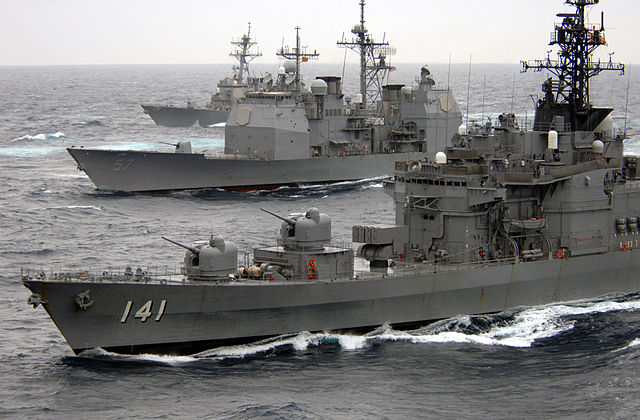
Of the huge fleet of 1941, there were no longer any ships of the line, nor cruiser, and only three destroyers, class Akizuki, and two carriers, the old Hosho (1922), demobilized, and the Katsuragi, well more recent (1944). These five units were taken into account by the new Ministry of the Navy, the second ministry of demobilization.
These ships for a few years skimmed Pacific islands to bring home isolated Japanese garrisons. They were later retired in 1947 and BU. The remainder of these surviving vessels consisted of coastal and light units, 53 minesweepers, former wooden-built submarine hunters (Cha type), and 12 light patrol boats, designed to serve as post-war trawlers.
They were assisted by high-sea patrol boats (Ukuru class) serving as supply vessels. The main role they were given was to clear Japanese waters of the 100,000 mines originally intended to block a US landing in January 1946. This force was incorporated into what was then known as the Maritime Safety Agency with two sections and to their heads, Admiral Yashio Yamamoto and Captain Tamura.
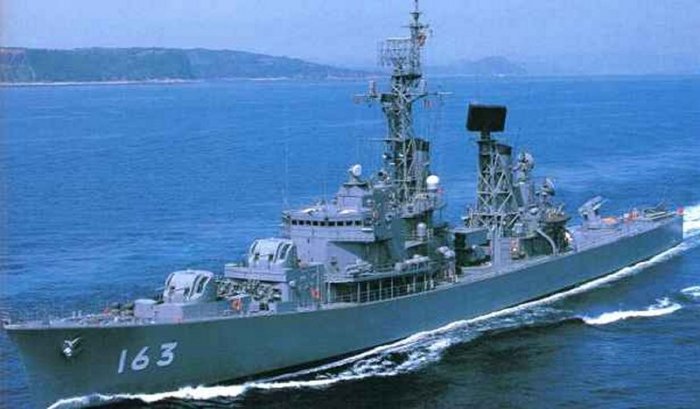
Under Article 9 of the new constitution, no military intervention force could be mobilized and the right to armed action to settle a different international could not be tolerated. However, from that time this principle was amended, if it were not to allow Japan, a maritime power, to guard its territorial waters and exercise a police role of traffic and fishing area protection, but also later to face the Soviet threat.
By the time the Japanese shipyards, largely bombed and devastated, were again operational, the US Navy transferred some vessels to the JMSDF (Japanese Maritime Self Defense Force), which was founded in 1954. The maritime security agency became the main force. of Japanese Coast Guard, modeled on the US Coast Guard. From this date, the reorganized shipyards would be able to build a fleet of larger units.
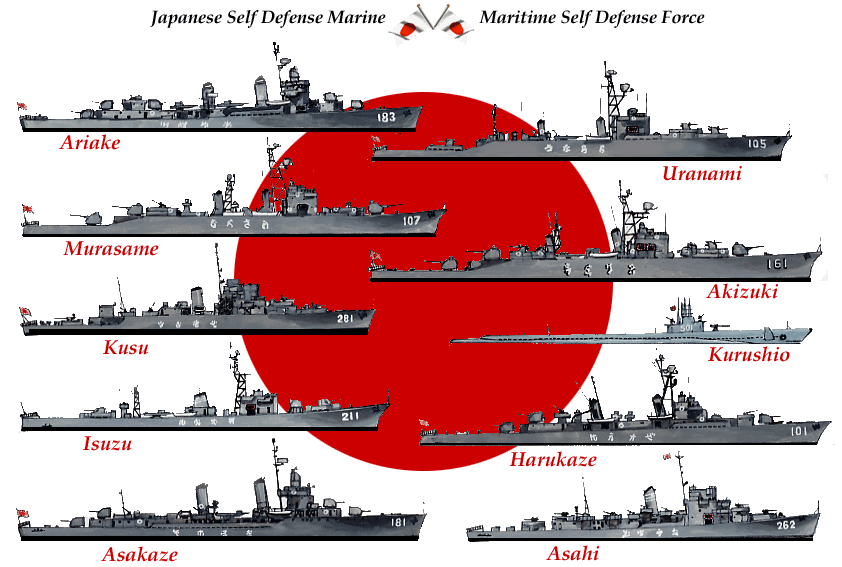
Articles to come
Harukaze class Destroyers
Ayanami class Destroyers
Murasame class Destroyers
Akizuki class Destroyers
Amatukaze missile destroyer ↗
Yamagumo class escort destroyers
Takatsuki class destroyers
Minegumo class escort destroyers
Haruna class helicoper destroyers
Tachikaze class missile destroyers
Shirane class helicopter destroyers
Hatsuyuki class missile destroyers
Hatakaze class missile destroyers
Asigiri class missile destroyers
Kongo class missile destroyers (started 1990)
Murasame class missile destroyers (started 1993)
Akebono/Ikazuchi class frigates
Kusu class frigates
Oyashio class Submarines
Ajisai class Landing Ships
Awaji class Patrol boats
Redburn class Patrol boats
Chifuri class patrol boats
Yahagi class patrol boats
Ukishima class Minesweepers
Yuhibari class Minesweepers
Ukuru class Minesweepers
Yashiro/Atada class Minesweepers
Type 1 class MTBs
Muroto class Coast Guards
Conventional JMSDF ships, early cold war (1947-60)
-19 Destroyers:
The big Akizuki (1941) having been scrapped there was only the only Wakaba, ex-Nashi, an escort destroyer of the class Tachibana (1945). It remained in service until 1972. Soon the US Navy transferred two Benson / Gleaves class destroyers in 1954 (Asakaze and Hatakaze) and two others of the Fletcher class (Ariake and Yugure). They remained in operation until 1969 and 1974 respectively. The shipyards then issued the first class of Japanese post-war destroyers, the Harukaze. To these two ships succeeded the 7 Ayanami, heavier, then the 3 Murasame and the two Akizuki. All were in service in 1960. They were classic buildings with artillery.
-23 Frigates:
The first were two acquisitions of the US Navy (Type GMT or Cannon class), the Asahi and Hatsuhi. They were operational from 1855 to 1975, soon joined by the first “escorts”, the Akebono, turbine and the two diesel Ikazuchi. But it was mostly the 18 class Tacoma frigates (Kusu) transferred in 1953 and operational until 1970-73.
-50 Assault ships:
These were 49 ex-US LSSLs, which had their rocket launchers removed from fire support and were using their light support artillery (Ajisai class). They were retired for many, and all in 1961. There was also the Yorikutei type LSM, an old ship that served first under the French flag in Indochina.
-2 Submarines:
After the transfer of the USS Mingo (Gato class) in 1955, under the name of Kuroshio, Japan launched its first classic attack submarine, the Oyashio in 1959.
-66 Patrollers/minesweepers:
Classes Awaji, Reburn, Chifuri, and Yahagi, built from 1951. There were also the 12 Ukishima, dating from 1945 and partially rebuilt, and the small Yuhibari, former auxiliary SM hunters of 1945, with 26 units survivors in 1960 (about to retire after their long demining work).
-17 Minesweepers:
There were the Ukuru, 5 former 1944 high-sea patrol ships reused as tankers and minesweepers. They were scrapped in 1963-66. From 1955, the USN delivered 9 YMS (Etajima class), 4 AMS/MSC (Yashima class) and Yashiro delivered the Yashiro in 1956, and the two Atada, larger ones. In addition, the Erimo, a deep sea minesweeper was transferred in 1955 and Tsugaru, a cable layer in 1955.
-10 Sub hunters:
They were the 7 Kamome class, inspired by the 1955-56 PC-Boats, the 1957 Great Hayabusa and the 1959 Umitaka.
-9 MTBs:
Type 1 and No. 7 and 8 (type 7) and No. 9 of British origin.
-20 Coastguards:
18 patrol boats of the 18 foot type were transferred in 1955, followed by the construction of the two Muroto class coastguard patrol boats (within the ASM – Maritime Safety Agency or MSA).

 ARIAKE class DDs
ARIAKE class DDs
Ariake and Yugure (ex. Heywood L. Edwards and Richard P. Leary) had been launched 6 October 1943 at Boston NyD, towed to Japan in 1959 to be transferred to the new fledgling navy. In 1936 both undergone reconstruction: Improved bridges, larger CiC, new radars, tripod mast. The number 3 5-in gun was discarded for weight saving. On Ariake, number 2 5-in gun was replaced by a weapon Alfa. Both ships were deleted in 1974.

 ASAKAZE class DDs
ASAKAZE class DDs
Both ships were Gleaves class destroyers, launched at Federal, Kearny (USS Ellyson) and Barth Iron Works(USS Malcomb), in 1941 and acquired 19.10.54. They were transferred under MDAP program, as the first Japanese postwar destroyers. New electronics were fitted, and the superfiring 5-in gun was discarded to make place for additional torpedo tubes. Both were returned to the USA in 1969; but then transferred again to Taiwan.

ASHAHI class Frigates: These were ex-Cannon class (DER) escort destroyers, launched in 1943 at Federal, Newark. Transferred 14.6.1955, under MDAP and returned to the US Navy in 1975.

 HARUKAZE class DDs (1955):
HARUKAZE class DDs (1955):
The first Japanese-built destroyers of the MSDF. Both were laid down at Mitsubishi Zosen, Nagasaki (Harukaze) and Shin Mistubishi HI Kobe (Yukikaze). They were designed and tailored for anti-submarine warfare. The majority of equipment was US-built, following Japan’s Mutual Defense Assistance Agreement. Sensor systems was also US standard like the AN/SPS-6 air-search radar, AN/SPS-5 surface-search radar, QHB search sonar, and QDA attack sonar.
They were armed with three 5-in/38 Mark 12 guns on Mark 30 single mounts of US manufacture, controlled by a Mark 51 director. But the JMSDF replaced the director by the Swedish-built modern GFCS developed by Contraves. On the Yukikaze, this was an American Mark 57 director. Other changes included K-guns and depth charge racks halved and later replaced by Mark 32 torpedoes. Two Mark 2 side launchers were also fitted.

Specs
Displacement: 1700- 2340 t FL
Dimensions 106 x 10.5 x 3.4 m
Machinery: 2 shafts Mitsubishi/Escher Weiss geared turbines or Westinghouse, 2 combustion engineering boilers or Hitachi/Babcock boilers, 30,000 bhp. 30 knots 6000 nm
Sensors: Radar SPS-5, SPS-6, Sonar SQS-29
Armament: 3x 5in/38, 8x 40 mm AA, 2 Hedgehod, DC rack, K-gun

 URANAMI class DDs (1957):
URANAMI class DDs (1957):
This second class comprised no less than seven ships, Ayanami, Isonami, Uranami, Shikinami, Takanami, Onami and Makinami. They were laid down between 20.11.1956 and 20.3.1959, launched 1957-1960 and completed 1958-60. Builders were Mitsubishi Zosen Nagasaki, Shin-Mitsubishi on Kobe, Kawasaki from Tokyo, Mitsui Zosen from Tamano, Oshikawajima from Kobe and Ino HI from Maizuru.
They were quite different in their approach compared to the Harukaze, with a smaller artillery, more emphasis in ASW warfare, better electronics and speed. The 3-in guns were American Mk33 models, under Japanese masks. The hull was not flush deck as there was a rear step down. During these times of nuclear fear, Ayanami tested eight wahs-down systems for removing irradiated dust. ECM was also a novelty, as well as air conditioning.
VDS was mounted on three ships, their TT banks removed and replaced by Mk8 “Poor Boy” launcher. Two units at the end of their active life were converted as training ships, without their 21 in TT mount to make room for a deckhouse. Electronics were Japanese-built, although based on US designs. All has been converted as training ships, starting in 1975 up to 1985 and deleted from 1986 to 1990.
Specs
Displacement: 1720- 2500 t FL
Dimensions 109 x 10.7 x 3.7 m
Machinery: 2 shafts Mitsubishi/Escher Weiss geared turbines or Westinghouse, 2 Mitsubishi -Nagasaki CE boilers, 35,000 bhp. 32 knots 6000 nm
Sensors: Radars OPS1, 15, Sonar SQS-12/14
Armament: 3x 3in, 1x 4 21in TTs, 2 torpedo racks, 2 hedgehog, 2 y-guns

 MURASAME class DDs (1958):
MURASAME class DDs (1958):
These three AAW destroyers which came back to a better armed solution, with new 5-in/54 guns in semi-automated Mk.39 turrets that went from the USS Midway, entirely rebuilt. However their poor rate of fire made them unsuitable as AA guns and needed large handling rooms and magazines to operate, so the hull was crowded and living conditions less than ideal.
They were also heavier than previous design, although the hull very much derived from the previous “-Nami” class. Mk 32 TTs made their apparition on two ships, Murasame and Harusame, the latter tested new systems as ASU 7006 in 1984 and latter a depot ship. All three had been built at Nagasaki (Murasame), Tokyo (Yudachi) and Yokosuka (Harusame), auxiliary in 1984 and deleted in 1984-89.

Specs
Displacement: 1838- 1840 t FL
Dimensions 110 x 11 x 3.7 m
Machinery: 2 shafts Ishikawajima geared turbines and boilers, 35,000 bhp. 32 knots, 6000 nm
Sensors: Radars OPS1, 15, Sonar SQS-29
Armament: 3x 5/54in, 3x 3in/50 AA, 2 ASW torpedo racks, 1 hedgehog, 2 y-guns, DC rack

 AKIZUKI class DDs (1959):
AKIZUKI class DDs (1959):
Last units of the “old design”, the two Akizuki and Teruzuki (Nagasaki and obe, launched june 1959, completed Feb. 1960, were built under the 1954 US Military aid, and carried the same 5-in/54 guns of the Murasame. They were however much larger, with a displacement of 23800/2890 tonnes FL, one more meter in beam and five meters overall lenght.
This was to make room for the particular sub-systems of the main guns. The forecastle hull in particular was lengthened to make room for additional command facilities as they were designed as flotilla leaders. They tested the infamous ASW mortar weapon Alfa, which was a failure.
Their sensors were modernized in 1977-78, and a 375 mm Bofors ASW mortar was adopted. Six 12.75 in Mark 32 ASW TTs were also adopted. VDS was installed and a SQS-23 sonar. They became auxiliaries in 1984-85 and were deleted in 1993.

Specs
Displacement: 2380- 2890 t FL
Dimensions 118 x 12 x 4 m
Machinery: 2 shafts Mitsubishi Escher Weiss geared turbines, 4 Mitsubishi CE boilers, 45,000 bhp. 32 knots, 6000 nm
Sensors: Radars OPS-1, 15, Sonar SQS-23, OQA-1 VDS
Armament: 3x 5/54in, 3x 3in/50 AA (2×2), 1 Weapon Alfa, 2 hedgehogs, 2 y-guns, 2×4 21-in TTs, DC rack
 Kusu class frigates (1953)
Kusu class frigates (1953)

These were eighteen 1943 Frigates of the US Tacoma class, declared surplus and acquired under on loan in 1953. They were named aft trees, like an IJN DD serie. There were basically unchanged but with some exceptions: Keyaki had an additional deckhouse added abat the mainmast to act as flotilla flagship and Kaeded received the same modifications. They were all technically returned in 1962, after the ten year loan, but in reality retransferred to the Japanese government the same day and ecquired definitively. They were decommissioned in the early 1970s (1970-73), however:
Kusu, Nara, Kashi and Momi were deleted in 1972, and Kahi was a moored training ship from 1965. Sugi was decomm. in 1970, Matsu deleted in 1942, as Kaya, Ume, Sakura, Nire and Shii were returned in 1970. Kiri was decomm. in 1970, as Keyaki, buna, Tochi, Tsuge and Kaede HS in 1968.
 Asahi class Frigates (1955)
Asahi class Frigates (1955)

Two Cannon class escort destroyers were transferred on 14.6.1955 under MDAP. Both were the returned to the US in 1975 and scrapped.
 Kurushio – Gato class Submarine USS
Kurushio – Gato class Submarine USS

Contrary to many NATO countries, Japan only operated a single GATO class submarine, the IJ Kurushio. This was the ex-USS Mingo, launched 1942 at Electric boat, transferre dunder MDAP in August 1955. SS 501 was still in her vintage appearance. She was not modernized along the GUPPY program. She basically served as a training boat, waiting for the first postwar Japanese submarine class to be ready: The Oyashio class (started two years later in 1957).
Organization, personal and structure of the JMSDF
Japan’s 1947 Constitution’s famous Article 9 stated “The Japanese people forever renounce war as a sovereign right of the nation and the threat or use of force as a means of settling international disputes.” Hence not only the name and general perception but structure and organization of the Japanese Forces on all three branches, to be focused on self-defense. Due to Cold War pressures however it was scaled up to the size appreciated by the United States to provide its own defense, and free local US forces, giving the latter more leeway into the deployment of the pacific fleet.
Constitution of the JMSDF (1 July 1954)
Between 1945 and 1954, about ten years of American occupation, Japan started with little resources barely sufficient to protect fishing areas. Dissolved by the Potsdam Declaration acceptance, the fleet was reduced to a collection of disarmed ships, some taken away as war reparation (to be blasted in nuclear tests in the American case). Others provided means for the repatriation of Japanese soldiers throughout the whole asia-pacific, plus minesweeping the home waters. This dagerous and tiedous task was given to the supervision of the Second Bureau of the Demobilization Ministry. The minesweers were transferred afterwards to the newly formed Maritime Safety Agency, maintaining resources adnd skills for the navy.
Japan’s 1947 Constitution Article 9 in particular stated “The Japanese people forever renounce war as a sovereign right of the nation and the threat or use of force as a means of settling international disputes.” This was interpreted as to allow only a self-defense force. But under Cold War pressures and forced United States alliance, Japan had to bring its own maritme assets to the local defence rather than relying only on the US Navy.
At last in 1952, the Coastal Safety Force was created, as part of the Japanese Maritime Safety Agency. It included the minesweeping fleet and auxiliary vessels including American transferred destroyers. Two years later, this Force was separated to become the core of the JMSDF, a simple branch of the Japanese Self-Defense Force (JSDF), fixated by a law.

Harukaze, the earliest Japanese cold war destroyer, as preserved.
In 1956, the JMSDF at last commissioned its first domestically produced destroyer, Harukaze. As the Cold War intensified, the JMSDF main task became the anti-submarine role. Both destroyers and frigates developed for the JMSDF were tailored for ASW warfare in priority. By 1970, this navy was sufficient in this frame to nor depend of the US Navy, which kept a permanent task force centered around a nuclear aircraft carrier. With Japan’s economy booming, the Navy also gradually benefited from constant increased in budget and by 1991 had achieved by tonnage an historical peak, both in quantity and quality of ships. They were perfectly able to take head on the Soviet Pacific fleet.
Composition of the Cold War JMSDF
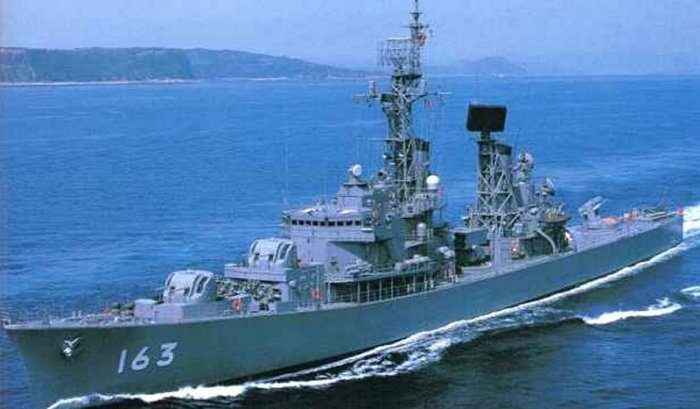
Amatsukaze, the earliest modern Japanese missile destroyer, 1963.
This chapter has been already thoroughly examined in the cold war page, but in the space of 40 years, the fleet scrapped her US-built or supplied ships and restarted naval construction with its own industrial giants, like Mitsubishi, already responsible for Japan’s tanks and some of her planes. The main doctrine that dominated Japanese cold war thinking was its role of a shield against any infiltration of the Soviet Pacific fleet submarines, in particular SNA and SSBNs.
In 1952, the Safety Security Force were created indeed as part of the Maritime Safety Agency, to create a minesweeping fleet and destroyers trsnaferred by the United States until one year later the JMSDF was formally created (1954 Self-Defense Forces Law). But soon it was integrated into the local USN policy and specialized on the ASW role to counter the Soviet’s powerful submarine fleet. This really was instrumental to understand the development of the shipbuilding industry through three main models, developed from 1958 and tailored for this role:
1-ASW destroyers, bearing names of former sunken WW2 IJN destroyers, which were the most numerous and indeed specialized, still with US-derived guns, radars, sonars, and weaponty such as ASROC and acoustic torpedoes.
2-Multirole destroyers, organic to ASW flotilla to ensure their protection against aerial and surface threats.
3-Helicopter destroyers, called for extra ASW capabilities
Alongside was developed a fleet of ASW corvettes, minesweepers, auxiliaries, and submarines, also to patrol Japanese waters, and later to patrol the Pacific, outside the extended Japanese EEZ, and specialized again in a submarine hunter role, despite their conventional propulsion.
Early japanese DDs were clearly tailored for ASW warfare, a role that was pushed forward as a condition to benefit from the MDAP program. Japan therefore accessed in the 1950s to the latest in weapons and sensors tech. The strenght of the Japanese cold war navy entirely rested on submarine warfare vessels, that gradually counted flotilla with one helicopter destroyer, generally two multirole, and more specialized ASW destroyers which made its strenght.
While the Harukaze, Ayanami, Murasame of the 1950s has been retired in 1990, the oldest Japanese DDs still active were the 1959 Akizuki class, of this early design (discarded 1993), and sole Amatsukaze (1963) that introduced a brand new Japanese DD design (discarded 1995). It was followed by the first class of ASW “escort destroyers”, the six Yamagumo class (1965-77). Moderately slow with their diesels, they were still capable of 27 knots and heavily armed for ASW warfare. Two became training ships in 1991, one an auxiliary, the others were still in service in the early 2000s.
The late 1960s will saw again a double class of four standard and three escort destroyers, the Takatsuki (1966-69) and Minegumo (1967-69). The first displaced 3100 tons, the second 2100 tons, 32 knots versus 27 knots. The first were heavily armed, but with slightly better antiship capabilities and more powerful electronics. The Minegumo were again ASW destroyers made for long range patrols. All were in service by 1990.
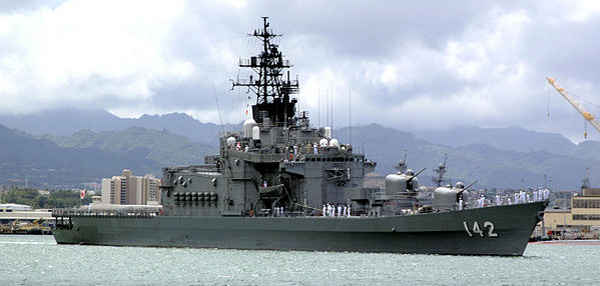
Helicopter Destroyer Hiei
1971 saw the arrival of the first Japanese Helicopter destroyer, Hiei. With on-board electronics being refined, airborne ASW warfare seemed a better solution and authorized the test of two massive destroyers, the largest postwar Japanese ships so far, bearing famous names also (used by former battleships): Hiei and Haruna. At 4700 tons standard, 6300 fully loaded, they were the largest and most powerful DDs in asia, capable of operating three large ASW HSS-2 heavy-duty long range helicopters.
The JMSDF Today

Izumo class carriers “helicopter destroyers”
As of today, what is now currently known as the “Japanese Navy” by simplification could barely stand as “defensive” as its ships numbers and quality tends towards a regional blue water navy. As of particular interest are the latest “helicopter cruisers” like the izumo class (Izumo and Kaga), capable of operating the F-35 and succeeding to the Hyūga class. The main reasons are two folds: The new Abe government’s own policy, encouraged by the Pentagon and of course the rapid rise of PLAN and regional ambitions of China. But this was the development of 31 years, from 1991 to 2022:
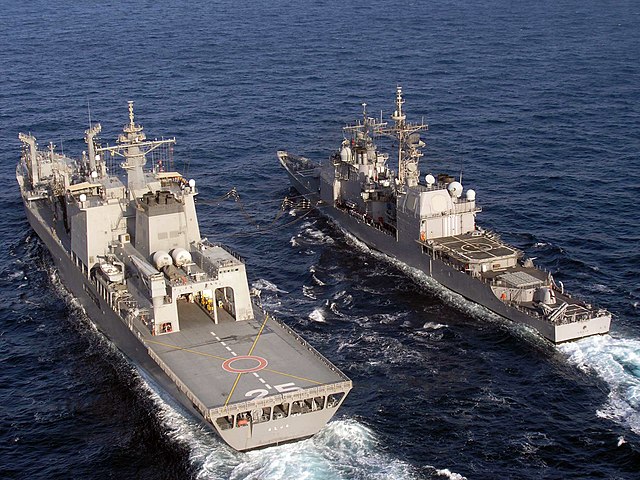
Following the end of the Cold War, the JMSDF role changed, and by 1991 Japan exceptionally broke its basic self-defence policy by allowing four minesweepers, a fleet oiler and a minesweeping tender to the Persian Gulf as part of Operation Gulf Dawn, clear mines left by Saddam Hussein and help resume merchant traffic in the area. It was followed by a mission in Cambodia in 1993, supported by JDS Towada and from there, Japan took part in a dozen UN-led peacekeeping operations in Asia.
In recoignition also of this change of polocy, Japan was granted in 1993 acquisition of the US top secret, state of the art Aegis system with Kongō. Thus, it took part in FTM exercizes after FTM-10. JFTM-1 started in December 2007. Japan took part in more multinational naval exercises led by the United States or India. U.S. Navy officials claimed in fact to have a much closer daily relationship to the Japanese Navy than any other, as shown in its systematic inclusion, into RIMPAC near Hawaii. Also Japan took part in the United States Navy’s Personnel Exchange Program (PEP), a full in,tegration of JMSDF personal into the USN for exchanges, and exercizes such as Keen Sword around Japan. But also Pacific Shield by 2004, 2007, hosting it that last year. Pacific Reach, a bi-annual submarine rescue exercise since 2000 and hosted in 2002. The naval staff also took part to Navy to Navy Talks, conferences with syaffs from Indonesia, Malaysia, Australia, UK in addition to the US, which had been more frequent and extended to discuss about the rapid rise of PLAN.
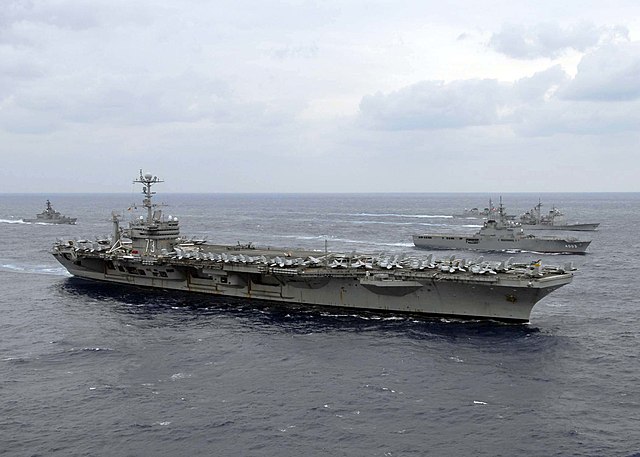
There has been in fact even a rotating schedule of destroyers in the Indian Ocean as part of Operation Enduring Freedom. Some also even took part in the growing threat of piracy in the region, between the horn of africa and red sea. In May 2010 decision was made for Japan to have a permanent naval base in Djibouti to operated its share of protection of merchant shipping from Somali pirates. This had been now ongoing for eleven years.
Today the JMSDF boast a fleet of 154 ships and 346 aircraft manned by 45,800 personnel. Main missions are still to protect Japanese sea lanes and patrol territorial waters, also taking part in UN-led peacekeeping operations and Maritime Interdiction Operations. This naval force is one of the strongest in the world, with some of the largest and most powerful destroyers ever built, including some hybrids like the Hyūga and Izumo class helicopter destroyers and AEGIS-capable Kongo class DDs. Japan started early a policy of building standard destroyers assisted by a couple of helicopter destroyers of various capacities. These modern ships are just aircraft carriers in all but name, a considerable leap forward in blue water capabilities, well beyond a strict defensive framework. Indeed to this day Article 9 of the Japanese Constitution still forbid Japan to built any aircraft carrier.
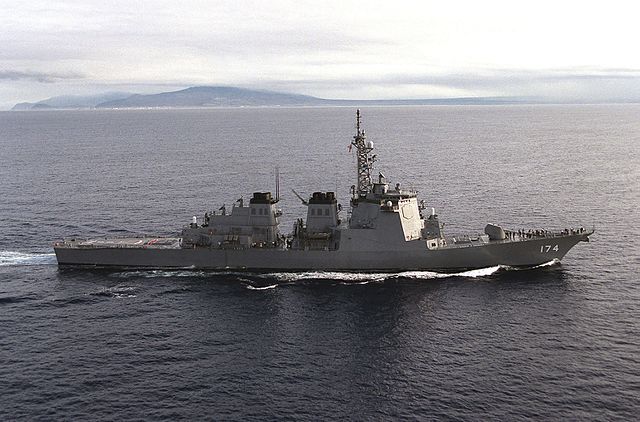
JDS Kirishima, of the Kongo class AEGIS DDs
Japanese Naval Air Service
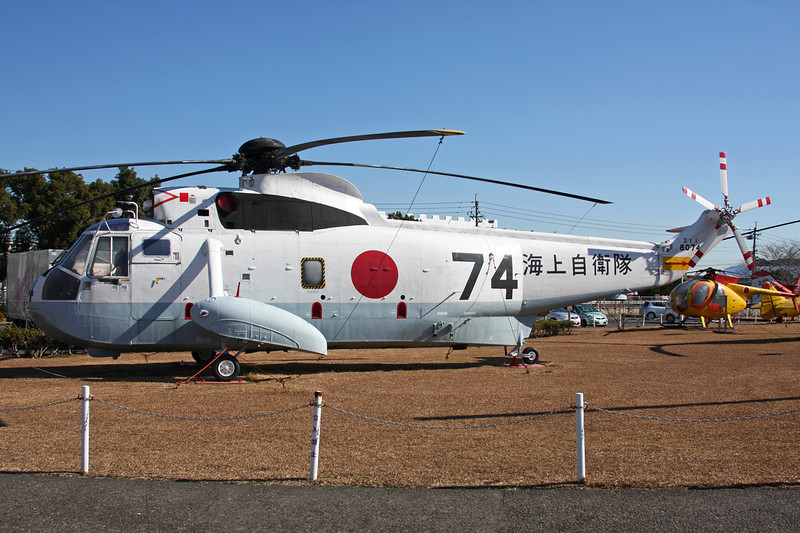
Japanese Mitsubishi HSS-2 ASW and SAR helicopter (Licenced Sikorski S61).
(To be completed)
Japanese Marines
(To be completed)
Japanese Coast Guard
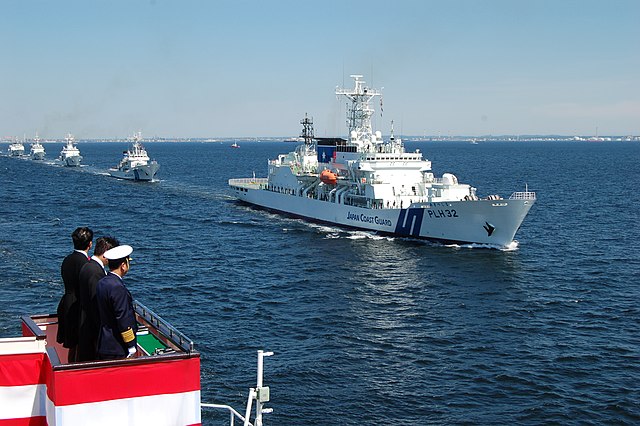
Prime minister Shinzo Abe and admiral Ishii reviews the Coast Guard.
The Japan Coast Guard (海上保安庁, Kaijō Hoan-chō) consists of about 13,700 personnel today, ensuring the protection of the coastline and part of the Ministry of Land, Infrastructure, Transport and Tourism. It was founded in 1948 as the Maritime Safety Agency, largely by the work from March 1946 of USCG Captain Frank M. Meals, but renamed as the coast guard for better international standardization in 2000. Its first tasks including preventing smuggling and illegal trade, black market and even piracy and illegal immigration. But also to clean up the numerous aerial mines laid by the US military in the waters around Japan in the summer of 1945. It became an important mission justifiying a large fleet of minesweepers, notably those of the former IJN as part of the MSA. In 1950, two flotillas also were sent to secure the Korean Peninsula waters under UN flag during the Korean War.
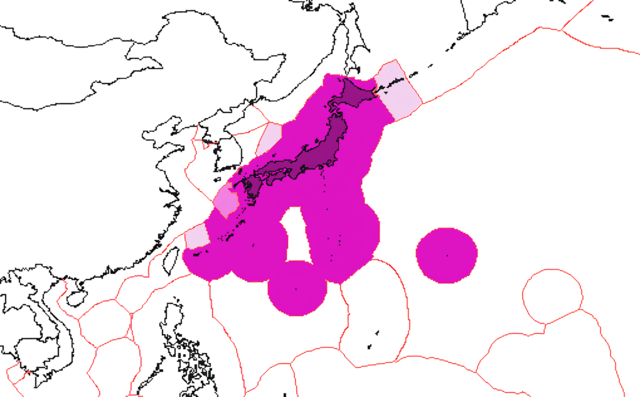
Its task today is to secure Japan’s extensive EEZ, one of the world’s largest, made of an Archipelago of 6,852 islands, including:
-The Ryukyu Islands: 1,394,676 km2 538,487 sqm2
-The Pacific Ocean waters around Japan: 1,162,334 km2, 448,780 Sqm2
-Nanpō Islands: 862,782 km2 333,122 Sqm2
-Sea of Japan: 630,721 Km2 243,523 Sqm2
-Minami-Tori-shima: 428,875 Km2, 165,590 Sqm2
-Sea of Okhotsk: 235 Km2, 91 Sqm2 (Claimed by Russia)
-Daitō Islands: 44 Km2 17 Sqm2
-Senkaku Islands: 7 Km2 2.7 Sqm2 (Claimed by China)
It’s assets comprises today some 455 vessels:
121 Patrol vessels
234 Patrol craft
63 Special guard and rescue craft
13 Hydrographic survey vessels
18 Aids to navigation tenders
One Aid to navigation evaluation vessel, 2 Buoy tenders, 3 training boats.
The Japanese Navy as of 2022
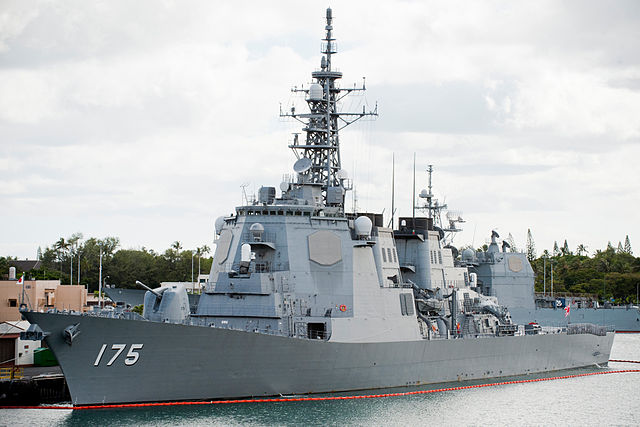
IJ Myoko of the Kongō-class (Kongō, Kirishima, Myōkō, Chōkai) of the 1990s
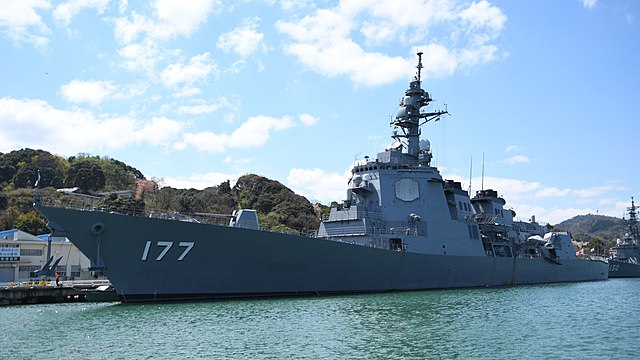
IJ Atago, of the namesake class (Atago, Ashigara, 2000s)
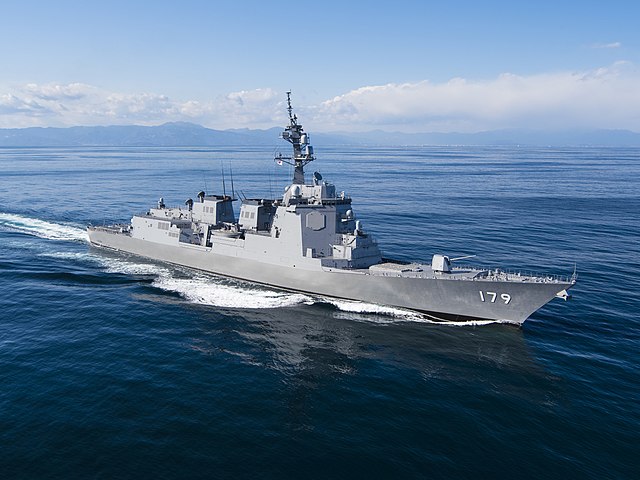
IJ Maya, of the namesake class (Maya, Haguro, 2010s).
(To be completed)
JMSDF ships of the Late cold war (1960-90)
These thirty years are the most interesting, seeing a real departure over previous design to larger, more powerful more US-inspired and often hybrid helicopter vessels. The transition went on for the next post-1990 decade were even more vigor, unlike western powers making massive budget cuts after the fall of USSR. It was due to the rise of the Chinese Navy, already the dominant naval power in the 2010s in the region, and now believed to be the first worldwide in tonnage. Since Shinzo Abe presidency, the JMSDF underwent reform and became the world’s fourth largest navy by total tonnage by 2000. Old, symbolic names from the days of the IJN had been revived with Aegis destroyers and aircraft carriers under disguise, since they are still officially “helicopter destroyers”. Budget expenditures are rising and next naval plans for the 2020-2030s are extremely ambitious, hardly compatible with a “self defence” force.
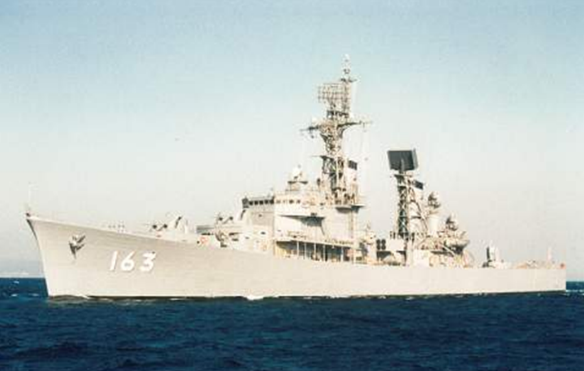
DDG 163 Amatsukaze was the first Japanese missile destroyer. Due to her limited size instead of a Terrier or Talos she was given the US Tartar missile system. Whe modernized in the 1980s, the Standard missile system, but also the RUR-5 ASROC system with Mk.112 octuple launcher afetr 1967. She was also the largest surface ship ever built in Japan since WW2, with almost double the displacement of 1950s destroyers. She was designed for AAW/ASW before the JMSDF alternate between AAW destroyers, ASW escorts and the much larger ASW destroyers. The Hatsusuki class (1980) was the first fitted with harpoon missiles.
Amatsukaze derived from the Akizuki class, and the Tartar system as its control system. Later she eaned an extended hull plus shelter cover design, improved steam turbines and SM-1.
She had an electronic suite and larger superstructure plus flush deck hull. She had no hangar but helipad. Later she had the AN/SPS-52, FCS-2-21D, AN/SPS-52 active and AN/SQS-23 passve sonars and NOLR-6B radar, OLR-9B missile warning system, OLT-3 jammer to stay active after the end of the cod war. Laid down on 29.11.1962, launched 5.10.1963 in Nagazaki, she was completed on 15.02.1965, discarded in 1995.
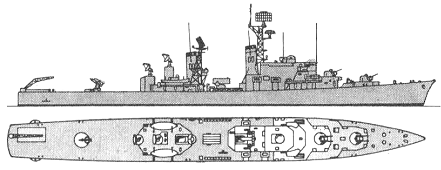
Amatsukaze, 2 views (src navypedia)

Amatsukaze, Conways
Specs
Displacement: 3050 tonnes standard, 4000 tonnes FL
Dimensions: 131 x 13.4 x 4.2 m
Machinery: 2 shafts Ishikawajima/GE geared turbines, 2 Ishikawajima/Foster-Wheeler boilers, 60,000 bhp. 33 knots, range 7000 nm
Sensors: Radars OPS-17, SPS-29, SPS-52, SPG-51, SPG-34, Sonar SQS-34, SQS-23
Armament: Mk13 launcher standard SAM (10 MR-1), 4x 3in/50 AA (2×2), 1×8 ASROC, 2 hedgehogs, 2 y-guns, 2×3 324mm Mk32 ASW TTs
Crew: 290
 Yamagumo class escort destroyers (1965)
Yamagumo class escort destroyers (1965)
Yamagumo, Makigumo, Asagumo, Aokumo, Akigumo, Yūgumo
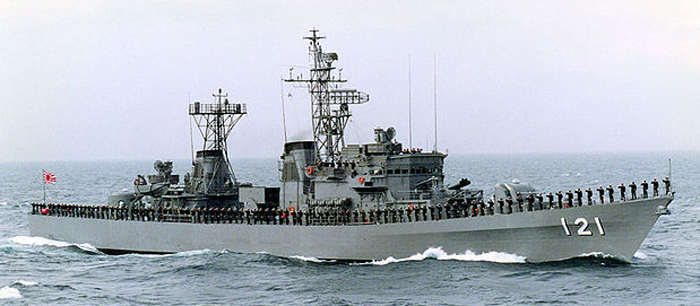
The Yamagumo class are vessels of the Japanese Maritime Self-Defense Force, usually classified as a destroyer, but due to their relatively light displacement, in other sources as a destroyer escort. This class is the successor of the Akizuki class.
This class was planned to become the new generation workhorse of the fleet of the JMSDF. In support of this objective, it was equipped with some new generation weapon and sensor systems such as the ASROC anti-submarine rocket and the OPS-11 early warning radar (Japanese equivalent of the American AN/SPS-40 radar).
The Minegumo-class destroyer derived from this class as the new DASH equipped version, but after the QH-50D DASH was scrapped, the JMSDF decided on resuming the construction of this class. The latter batch sometimes called as the Aokumo class, and there are some improvements, mainly in their electronics such as the OQS-3 hull-sonar (Japanese variant of the American AN/SQS-23) and the AN/SQS-35 variable depth sonar system.

Yamagumo profile, Conways
Specs
Displacement: 2,050-2,200 long tons standard
Dimensions: 114-115.2 m (374ft) oa x 11.8 m (38 ft 9 in) x 3.9 m (12 ft 10 in)
Machinery: 2 shafts 4+2 × Mitsui 1228/1928 V3 BU-38V, 6 × Mitsubishi 12 UEV 30/40 diesels, 26,000 bhp
Performances: 27-28 knots (32 mph; 52 km/h), range 6,000 nmi (11,000 km)
Sensors: Radars AN/SQS-23, Mark 56/63 FCS OQS-3 sonar, VDS AN/SQS-35(J), OPS-11B, OPS-17 NOLR-1B/6
Armament: 4 × Mk.33 3″/50, ASROC, Bofors 375 mm (15 in) ASWRL, 2 × HOS-301 324 mm (12.8 in) TTs
Crew: 210-220
 Takatsuki class missile destroyers (1966)
Takatsuki class missile destroyers (1966)
Takatsuki, Kikuzuki, Mochizuki, Nagatsuki
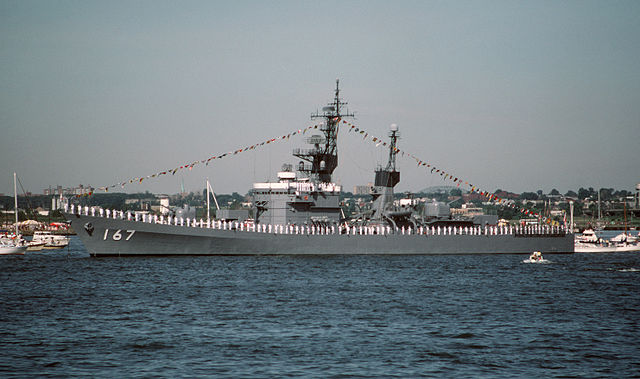
The Takatsuki class destroyers were designed mainly for anti-submarine warfare. They were laid down in 1964-68, launched 1966-69 and completed 1967-70.
They were powered by a mixed machinery like the previous class, with for the Takatsuki and Nagatsuki two Mitsubishi/WH reaction/impulse steam turbines and two Mitsubishi CE water tube boilers. Kikuzuki differed with her two Mitsubishi/EW impulse steam turbines and Mochizuki her Kawasaki Model NH-300 impulse steam turbines coupled with Model BD-120-1 water tube boilers. These all provided 60,000 shp (45 MW) on 2 shafts for 32 knots (37 mph; 59 km/h) and a range of around 6,000 nmi (11,000 km) at 16 knots.
Sensor-wise, they carried the OPS-11B EWR, OPS-17 SSR, AN/SQS-23, AN/SQS-35(J) suite as completed, with Mark 56 fire-control system. In the 1986 refits, they obtained the OPS-11C EWR radar and the NOLR-1B, NOLQ-1 chaff/ECM systems.
The armament also changed over time. When completed, these four 3,000 tonnes destroyers carried two Mk.42 5 in (127 mm) guns, one ASROC, a quad Bofors 375 mm (15 in) ASW Rocket Launcher (ASWRL), two triple Mk.32 ASW torpedo tubes and two QH-50D DASH anti-submarine drone helicopter.
After their 1986, they had one Mk.42 5 in (127 mm) gun removed aft, two quad RGM-84 Harpoon canister SSM added, and in place of the aft gun, a octuple 8 Mk.29 Sea Sparrow. For antimissile defence they earned a single Mk.15 CIWS, and kept the ASROC, Bofors ASWRL and TTs. However this 1985-1988 refit concerned Takatsuki and Kikuzuki (Sea Sparrow Harpoon). Phalanx CIWS systems were installed on Kikuzuki only. They also gained a new fire control system/radar, FCS-2-12 and TASS. Mochizuki and Nagatsuki were not upgraded. They were all retired post-1995, the first two retired in 2003-2008. Despite their greater armament, modernization implied better automation and they came from 270 to a 260 strong crew.

Takatsuki profile, Conways
Specs
Displacement: 3,100 t standard, 4,500 t full load
Dimensions: 136 x 13.4 x 4.4m (446 ft 2 in x 44 ft x 14 ft 5 in)
Machinery: 2 shafts Kawasaki steam turbines, 2 watertube boilers, 60,000 bhp. 32 knots, range 6,000 nm
Sensors: Radars OPS-11B EWR, OPS-17 SSR, AN/SQS-23, AN/SQS-35(J)
Armament: 2x 5in guns, ASROC, 1 ASWR, 2×3 324mm Mk32 ASW TTs, 2 DASH drones
Crew: 270
 Minegumo class escort destroyers (1967)
Minegumo class escort destroyers (1967)
Minegumo, Natsugumo, Murakumo
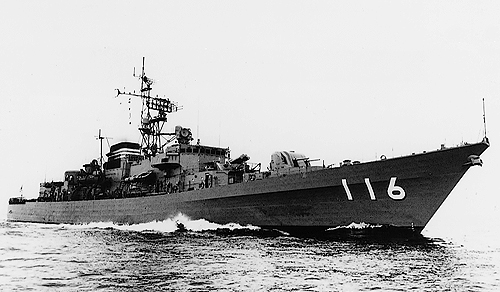
The Minegumo class represented a new, smaller and cheaper destroyer concept, as successor of the Yamagumo class, derived from it but fitted with the QH-50D DASH ASW drone instead of her ASROC system. Her main task was also Anti-submarine warfare. In 1969 Production of the QH-50D system was terminated and thus the class was cut after the third ship.
The JMSDF considered the creation of large helipad for a Kaman SH-2 Seasprite helicopter, but this plan was abandoned on budget cost issues. Nevertheless, DASH and its facilities were removed in 1979-82, replaced back by the Mk.16 GMLS/ASROC instead. Murakumo was refitted in 1978 and tailored to be used as gunnery trials vessel with her aft Mk.33 gun removed, replaced by the Italian OTO Melara 76 mm gun to be tested.
All three were decommissioned in 1999 and 2000.

Minegumo profile, Conways
Specs
Displacement: 2,100 tonnes standard, 2,750-2,794 tonnes FL
Dimensions: 115 x 11.8 x 3.8 m (377 x 38 x 12 ft)
Machinery: 2 shafts Ishikawajima geared turbines, 2 Ishikawajima boilers, 50,000 bhp. 32 knots, range 7,000 nm
Sensors: Radars OPS-11B EWR, OPS-17, sonars OQS-3, SQS-35, Mark 56 FCS, NOLR-1B EW
Armament: 2 × Mk.33 twin 3″/50 guns, Bofors 375 mm (15 in) ASWRL, 2 × HOS-301 324 mm TTs, 2 × QH-50D DASH
Crew: 210

JDS Haruna (DDH-141) passes Hospital Point in Pearl Harbor, Hawaii
The Haruna-class destroyer were a first for Japan, and required an authorization for their unusual tonnage. Japan was forbidden to built aicrarft carriers and ships beyond 5,000 tonnes (standard) as defined in 1946. But the need of better ASW solutions to deal with the Soviet Submarine problem forced the Japan Maritime Self-Defense Force (JMSDF) to lift these limits, and plan for its first “helicopter destroyer” in the early 1970s. There had been helicopter carrying destroyers in the past, but they often had a simple helipad or at bast a small hangar. They were more common on cruisers. Hybrid helicopter crisers like the Soviet Moskva class however showed the way. For it to better pass budget approval, these vessels, sized like cruisers (they were larger than the Italian helicopter cruisers Andrea Doria !) were designated DDH. They were also very peculiar, built around a large central hangar housing up to three large helicopters. These were no longer the Kaman type bu licence-built Seawhawk, SH-60J(K) anti-submarine helicopters, with far better range and weapons, sensors array.
Originally, the JMSDF intended in 1960 to plan through the Defense Agency a single, experimental helicopter carrier (CVH) with the Second Defense Build-up Plan. It was later cancelled as fleet aviation was spread among destroyers instead. The Japanese DDH was completely recast as a simple “extended Takatsuki” with her weaponry concentrated forward (two 5-inch/54 cal. Mark 42, a Type 74 octuple missile launcher, and a large hangar and 50 m flight deck, complete with three spots. The Japanes FRAM program of 1983-1984 changed the armament to Sea Sparrow launchers, Phalanx CIWS, chaff launchers and better ECM/EEW systems as well as the Naval Tactical Data System (NTDS) coupled with the OYQ-6/7 combat direction system. As for their powerplant, they had new boilers working at 850 psi (60 kg/cm², 5.9 MPa), 430 °C for a total of 60,000 hp (45,000 kW).
Eventually the planned prototype became a class: DDH-141 Haruna started on 19 March 1970, launched 1 February 1972 and completed on 22 February 1973 in Maizuru and DDH-142 Hiei, laid down 8 March 1972, launched 13 August 1973, completed 27 November 1974, in Kure. The first was discarded and BU on 18 March 2009 and the second on 16 March 2011. The formula was considered a success, leading to the construction of the larger 1978 Shinane class and in the 2000s to a brand new replacement generation looking like conventional CVH: The Hyuga and Izumo class.

Haruna profile, Conways
Specs
Displacement: 4,950 t standard, 6,900 t full load
Dimensions: 153.1 x 17.5 x 5.2m (502 x 57 x 17 ft)
Machinery: 2 shafts Ishikawajima geared turbines, 2 Ishikawajima boilers, 60,000 bhp. 32 knots
Sensors: Radars OPS-11, OPS-17 (later 28), Sonar QQS 3.
Armament: 1×8 Sea Sparrow Mk.29 SAM, ASROC, 2× 5″/54 Mk.42 guns, 2 Phalanx CIW, 2 Mark 32 TTs
Aircraft carried: 3x SH-60J(K) ASW helicopters
Crew: 360
 Tachikaze class missile destroyers (1974)
Tachikaze class missile destroyers (1974)
Tachikaze, Asakaze, Sawakaze
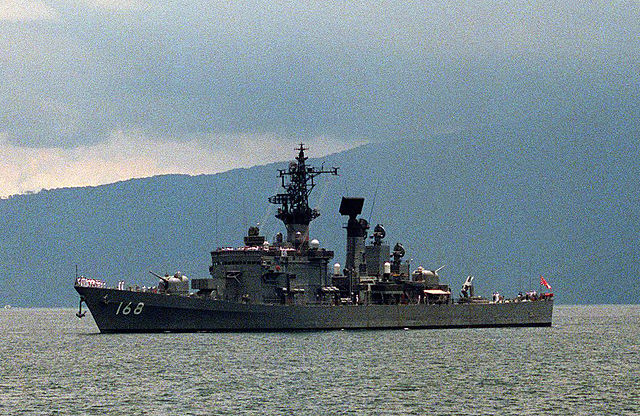
The Tachikaze-class destroyers were a new generation of versatile guided missile destroyer class, succeeding Amatsukaze, ten years prior. They benefited from successive improvements after completion and notably their C4I systems. Specialized in air-defense to ensure protection of ASW groups, they were succeeded by the Hatakaze class. Like those before and after, all were named after WW2 destroyers lost in action.
The Tachikaze class received the US Tartar-D system, and Standard-1 MR missile integrated with the Naval Tactical Data System (NTDS), for the first time on a warship in Japan. It wasq coupled with the OYQ-1 Weapon Entry System (WES) tested on JDS Tachikaze. The OYQ-1 WES derived from Takatsuki’s NYYA-1 but for the first time coupled with C4I system with NTDS. Asakaze had an improved OYQ-2 Target Designation System (TDS) and Sawakaze the new OYQ-4. Apart the Standard-1 MR and its Mk 13 launcher they received the Type 74 Mark 16 GMLS ASROC, two quad canister of Harpoon SSM, two Phalanx CIWS, two Type 68 324 mm TTs, and as usual two 5-inch/54 cal. Mark 42 main guns.
In 1998, Tachikaze became a flagship with her aft 5-inch gun replaced by a new blockhouse fitted for fleet command. Tachikaze was discarded in 2007, Sawakaze vecoming the new flagship, and was decomm. in 2010, Asakze in 2008.

Tachikaze profile, Conways
Specs
Displacement: 3,850 t standard, 3,950 t FL
Dimensions: 143 x 14.3 x 4.6-4.7m (469 x 46 x 15 ft)
Machinery: 2 shafts Mitsubishi geared turbines, 2 Ishikawajima boilers, 60,000 bhp. 32 knots, range 5,000? nm
Sensors: Radars OPS-11, OPS-17 (later 28), Sonar QQS 3.
Armament: 2x 5-in/54 Mk42, 2x CIWS, 1x Mk13 SAM (MR-1), 2×4 Harpoon SSM, Type 74 ASROC, 2×3 HOS-301 324mm ASW TTs
Crew: 250-255
 Shirane class helicopter destroyers (1978)
Shirane class helicopter destroyers (1978)
Shirane, Kurama
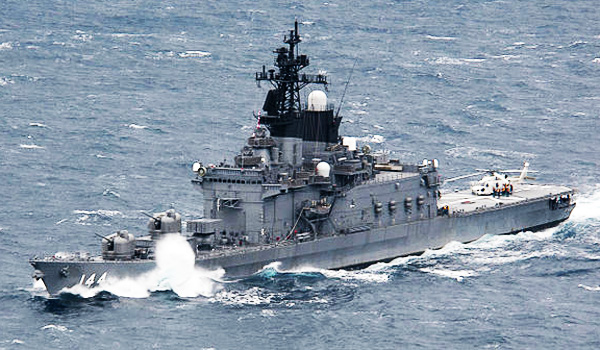
The Shirane were a repeat, but much improved version of the Haruna-class destroyers. The propulsion was upgraded due to the scale of the new ships to an output of 70.000 hp for 32 knots (she had new IHI boilers working at 850 psi (60 kg/cm², 5.9 MPa), 430 °C) for a displacement of 7,200 tonnes at Full Load. Also at 160 m long they were the largest warships ever built in postwar Japan, delivered by Yokosuka and Sasebo.
The Shirane class kept the same hybrid design, with the armament concentrated forward, and a large deck aft plus hangars to operate all sorts of medoum to heavy helicopters. Initially these were “only” three SH-60J(K) anti-submarine helicopters like their precedessors. More could be stored on deck spots.
The armament included two Mk.42 127mm guns, 20-mm Phalanx CIWS (close-in weapon systems) a single RIM-7 Sea Sparrow SAM, same triple torpedo banks and ASW rockets. Their elecronics suite was modernized and they gained a NOLQ-1 integrated suite with OLR-9B RWR and Mark 36 SRBOC. They were completed in 1980-81 and served until replaced by the new, very large Izumo-class helicopter destroyers, discarded in 2015 and 2018 respectively.

Shirane profile, Conways
Specs
Displacement: 5200 tonnes standard, 7500 tonnes FL
Dimensions: 159 x 17.5 x 5.3 m (522 x 57 x 17 ft)
Machinery: 2 shafts Ishikawajima geared turbines, 2 IHI boilers, 70,000 bhp. 32 knots, range ?
Sensors: Radars OPS-12 3D, OPS-28, sonars OQS-101 bow, SQS-35/SQR-18 VDS-TASS
Armament: Sea Sparrow SAM, ASROC Mk 112, 2 × FMC 5″/54 Mark 42, 2× CIWS, 2 × Mark 32 TTs, 3 Helicopters
Crew: 350-360
 Hatsuyuki class missile destroyers (1980)
Hatsuyuki class missile destroyers (1980)
Hatsuyuki, Shirayuki, Mineyuki, Sawayuki, Hamayuki, Isoyuki, Haruyuki, Yamayuki, Matsuyuki, Setoyuki, Asayuki, Shimayuki
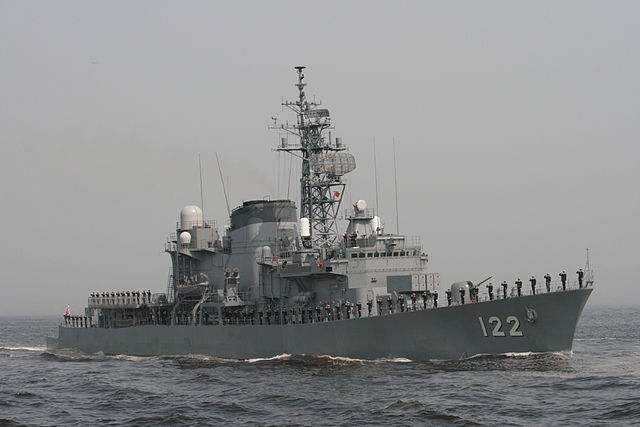
This was the largest post-war destroyer progral in Japan. The goal was to replace the entire 1950s generation of early ASW destroyers. This twelve ships were built at Simitomo, Hitachi, Mitsubishi, IHI, and Mitsui, yards usually not accustomed to military vessels, unless Yokosuka, Kure, Sasebo or Maizuru. Laid down in 1979-84 and completed in 1982-87, so close to the end of the cold war. Between anti-aircraft gunfire-oriented destroyers (DDA) and ASW destroyers (DDK) they were also the result of the 1970s reorganizaiton of squadrons dur to the gorwing threat of Soviet nuclear submarines. The concept adopted was a group of eight ships for eight helicopters, any flotilla being composed of a single helicopter destroyer (DDH), five general-purpose destroyers (DD), and two guided-missile destroyers (DDG).
The Hatsuyuki were the first of these new generation General-purpose destroyers (Hanyou-goei-kan) combining both AA and ASW capabilities as well as helicopters. The core was the new the OYQ-5 Tactical Data Processing System (TDPS) comprising the AN/UYK-20 computer, five OJ-194B workstations with datalink 14 (STANAG 5514). They were also the first to drop the traditional gear turbines and steam boilers for four gas turbines, two for cruising and two for speed. They also received later a full ECM suite, with the NOLR-6C intercept array, OLT-3 jammer, and Mark 36 SRBOC chaff launcher plus towed torpedo decoys. They also carried either a HSS-2B or a SH-60J helicopter and the crew was just 200 strong thanks to greater automation.
Four ships were later repurposed for training in 19999-2016: JS Shimayuki), Shirayuki, Setoyuki and Yamayuki. They were decommissioned in 2016-2022 (this year).

Hatsuyuki profile, Conways
Specs
Displacement: 2,950 tonnes standard, 4,000 tonnes FL
Dimensions: 130 x 13.6 x 4.2 m (430 x 45 x 14 ft)
Machinery: 2 shafts, 2 KHI-RR TM3B + 2 gas turbines, KHI-RR RM1C, 45,000 + 9,900 bhp. 30 knots
Sensors: Radars OPS-17, SPS-29, SPS-52, SPG-51, SPG-34, Sonar SQS-34, SQS-23
Armament: 1× OTO Melara 76 mm, 2 CIWS, 2×4 Harpoon SSM, 1×8 Sea Sparrow SAM, ASROC, 2×3 324 mm TTs, 1 Helicopter.
Crew: 200
 Hatakaze class missile destroyers (1984)
Hatakaze class missile destroyers (1984)
Hatakaze, Shimakaze
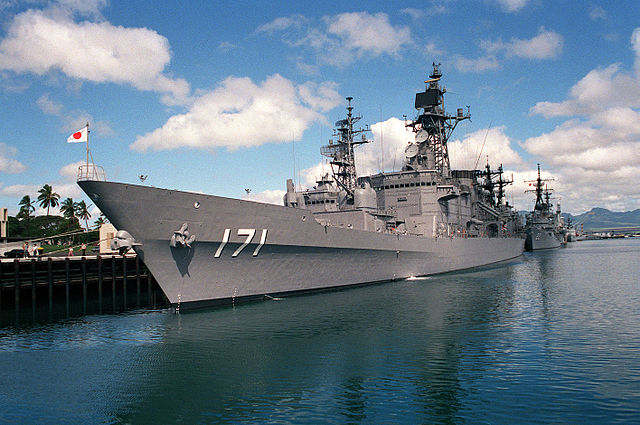
The Hatakaze class were large guided-missile destroyers, the third generation built for the JMSDF and like the previous class, the first to have gas-turbine propulsion. They had the same ecomputer and datalink as the previous Tachikaze class, but improves since they were both intended to be used as group flagship, being roomier than the Tachikaze. They were meant to function as command ships. They operated the OYQ-4-1 tactical control system with the Standard SAM, ASROC, RGM-84 Harpoon, Mark CIWS, triple ASW TTs but instead of the light 3-in OTO Melara pf their predecessors they still relied on the much larger 5 inch/54 caliber Mark 42. With automation despite their size their crew in standard condition was down to 260.
Laid down in 1983 and 1985 at Yokosuka and Sasebo they were commissioned in 1989-88. Both had been converted as training vessel in 2020 and 2021 respectiovely for the new generation of guided missile destroyers of the Kongo lineage. They were also the largest JMSDF vessels, even compared to the Shirane class. They are still in service today, planned to stay active at least until 2025.

Hatakaze profile, Conways
Specs
Displacement: 4,600 tonnes standard, 6,000 tonnes FL
Dimensions: 150 x 16.4 x 4.8 m (492 x 53 x 16 ft)
Machinery: 2 shafts COGAG Kawasaki RR Spey SM1A, RR Olympus 72,000 hp, 30 knots
Sensors: Same as Tachikaze
Armament: 2×4 Harpoon SSM, Standard SAM, ASROC, 2× 5″/54 Mark 42, 2× CIWS, 2×3 Type 68 TTs
Crew: 260
 Asagiri class missile destroyers (1986)
Asagiri class missile destroyers (1986)
Asagiri, Yamagiri, Yūgiri, Amagiri, Hamagiri, Setogiri, Sawagiri, Umigiri
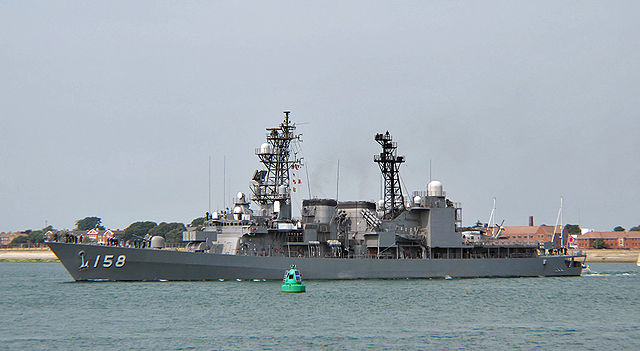
This was the second class of new multirpurpose destroyers. Improved version of the Hatsuyuki class, which due to budget constraints the design was compromised for C4I function, resistance, and durability. These FY1983 planned desotroers were built back in large or military yards and an evolved design with expanded hull, enhanced equipment.
They were not only enlarged Hatsuyuki class, with superstrcture made of steel, and instead of COGOG they had COGAG, combining four Kawasaki-Rolls-Royce Spey SM1A gas turbines, enabling 26 knots (48 km/h; 30 mph) on just two engines with much greater range to track nuclear submarines much longer. The alternated arrangement improved resistance and durability, recalling the good old steam turbines. They had at forst the OYQ-6 combat direction system (CDS) with the same AN/UYK-20 computer but expanded memories, and datalink-11, later upgraded to the OYQ-7 with the OYQ-101 ASW Direction System. For C4I they used the Superbird SHF-SATCOM.
They also had the new OPS-28 air-search radar, OPS-14C and later OPS-24 3D, while electronic warfare was uopgraded with NOLR-8. Armament however remained the same with a more modern FCS but they now operated a permanent SH-60J shipboard helicopter with a hangar large enough for two. Laid down In 1986-89, at the end of the cold war, they were completed in 1988-91 as it ended. Needless to dyay their are still in 2022, fully active, two early ships being converted as training vessels in 2011 and 2012. Decommission dates would be around 2030, and with the rise of the Chinese PLAN and recent demonstrations in the yallow sea, it is likely they would be kept active longer after intensive modernization.

Asagiri profile, Conways
Specs
Displacement: 3,500 tonnes standard, 5,200 tonnes FL
Dimensions: 137 x 14.6 x 4.5 m (450 x 47 x 15 ft)
Machinery: 2 shafts COGAG, 4 Kawasaki RR Spey SM1A, 54,000 bhp. 26 knots, range 6,000 nm
Sensors: Radars OYQ-6/7 CDS, OPS-14/24, OPS-28, Sonars OQS-4A, OQR-1 TASS
EW: NOLR-8 intercept, OLT-3 jammer, Mark 36 SRBOC, AN/SLQ-25 torpedo decoys
Armament: As Hatsuyuki
Crew: 220
 Kongo class missile destroyers (1991)
Kongo class missile destroyers (1991)
Kongō, Kirishima, Myōkō, Chōkai
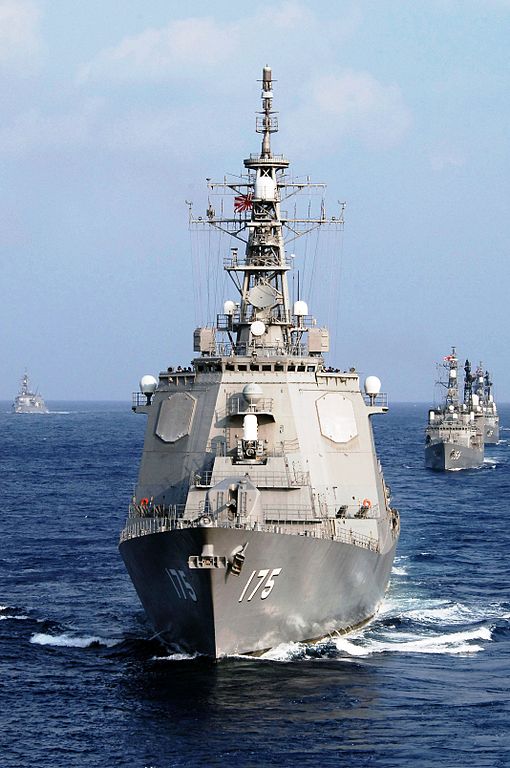
The Kongō class marked a clear new generation of large missile destroyers, symbolic of the rapid rise in capabilities of the JMSDF. This was reflected in their electronics capabilities with a local variants of the USN AEGIS system, new looks and size, and new names, those of capital ships and heavy cruisers of the IJN. Quite a symbol. But they were also started at the very end of the cold war, started in 1990-95 and completed in 1993-98.
Not off-topic since the first was indeed laid down before of “official” end of the cold war in December 1991 and they were studied from 1986 as a replacement for the earlier 1970s DDs. The main start of their design was that the JMSDF estimated its fleets would not survive against airborne strikes from Tupolev Tu-22M bombers with the new AS-4 missile. This conducting the government to ask some help from the US, to acquire the Aegis Weapon System (AWS). In 1984, concrete implementation plans started, agreements were signed, an full replication in Japan also. Construction of the first Japanese Aegis-equipped ships was under the FY1988 program.
The overall design followed the Arleigh Burke-class with a shelter deck design widened to support a brand new, much taller superstructure, with four PESA antennas and inclined hull outer panels to reduce waterline lines, also reducing radar cross section, hence improving stealth as well. They were also to carry extra commanding equipment. They had a vertical mast and enlarged superstructur for headquarters equipments as flagship. The propulsion system was also a replica of the Arleigh Burke class with four Ishikawajima-Harima LM2500 gas turbines for 30 knots.
The Kongo class were the first Japanese modern warships to nearly reach the treshold of 10,000 tonnes fully loaded.
These were also the first Japanese destroyers equipped with a versatile Mk41 vertical launching system, operating the following:
-SM-2MR Surface-to-air missile
-SM-3 Anti-ballistic missile
-RUM-139 Anti-Submarine Rocket
-RIM-162 Surface-to-air missile
Also their triple HOS-302 torpedo tubes banks were able to operate either the Mark 46 torpedo or the Type 73, both acoustic for ASW warfare.
Each could operate a SH-60J/K helicopter, but without hangar.
With the rapid rise of the Chinese PLAN, this was quickly outdone by the next classes, the 2005 Atago, and 2018 Maya class. Plans for a larger replacement, possibly a cruiser class (to rival the Chinese Type 055 notably), is currently studied for the FY2023 program. As of today, the JMSDF possesses eight AEGIS destroyer and Japan was the first nation to obtain this technology outside the US, followed by Spain and South Korea.

Kongo profile, Conways
Specs
Displacement: 7,250 tonnes standard, 9,500 tonnes FL
Dimensions: 161 x 21 x 6.2 m (528 x 69 x 20 ft)
Machinery: 2 shafts, 4 Ishikawajima Harima/GE LM2500-30 gas turbines, 100,000 bhp. 30 knots, range 5,200 nm/20kts
Sensors: AEGIS, NOLQ-2, OQS-102 sonar
Armament: 1× 5 in/54 Oto,2×4 Harpoon, 2x CIWS, 2× HOS-302 TTs, 90-cell Mk 41 VLS, 1 helicopter
Crew: 300
 Murasame class missile destroyers (1994)
Murasame class missile destroyers (1994)
Murasame, Harusame, Yūdachi, Kirisam, Inazuma, Samidare, Ikazuchi, Akebono, Ariake
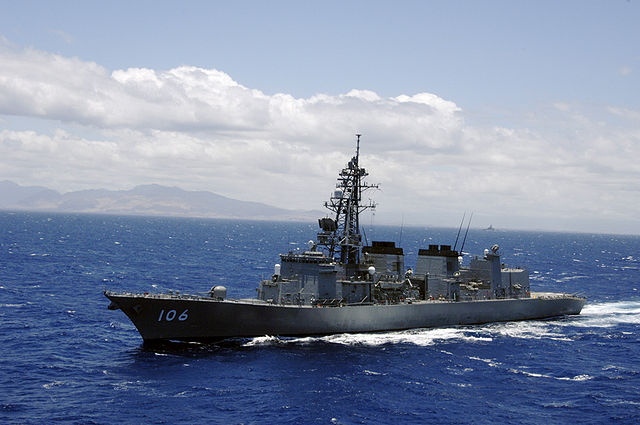
Following their FY1977 policy of having a fleet of general-purpose destroyers under the ‘8-8’ helicopters concept, FY1986 planned twenty 1st gen of these, twelve Hatsuyuki, eight Asagiri class to fill all four flotillas. It was planned long term to shift to destroyer escorts for local District Forces but performance obsolescence became a concern and it was decided to advance a second generation of these versatile DDs. As many former, they were named after WW2 sunken IJN destroyers.
They were also much larger in size, reaching 6,200 tonnes fully loaded. In all, 14 were planned, but just 9 were completed are are currently active at least until 2040. With the 2008 financial crisis the next five were cancelled. They were laid down in 1993-99 so truly post-cold war vessels, completed in 1996-2002. The five cancelled were replanned with a completely new design in mind, of the third generation, the Takanami class (launched 2001-2004), followed by four AEGI equipped, stealthy Akizuki-class destroyers (2010) and the two Asahi-class destroyers (2016), all of the 3rd gen. It is planned to return to a slightly larger class in numbers by the 2020s.
They were also the first of that type fitted with two Vertical launcher systems (VLS) to fire the Evolved Sea Sparrow SAM and the VL-ASROC.

Murasame profile, Conways
Specs
Displacement: 4,450 tonnes standard, 6,200 tonnes FL
Dimensions: 151 x 17.4 x 7.2 m (495 x 57 x 1 ft7)
Machinery: 2 shafts COGAG, 2x IHI-GE LM2500, 2x KHI-RR SM1C 60,000 bhp. 30 knots
Sensors: OYQ-9 CDS, OYQ-103 ASWCS, FCS-2-31, OPS-24B, OPS-28, sonars OQS-5 OQR-2 TASS
EW: NOLQ-3 suite, Mk 36 SRBOC, AN/SLQ-25 torpedo decoys
Armament: 1× OTO Melara 76 mm, 2x CIWS, 2×4 Harpoon, 2×3 324 mm TTs, 2x 16-cell Mk 48/Mk 41 VLS.
Crew: 165

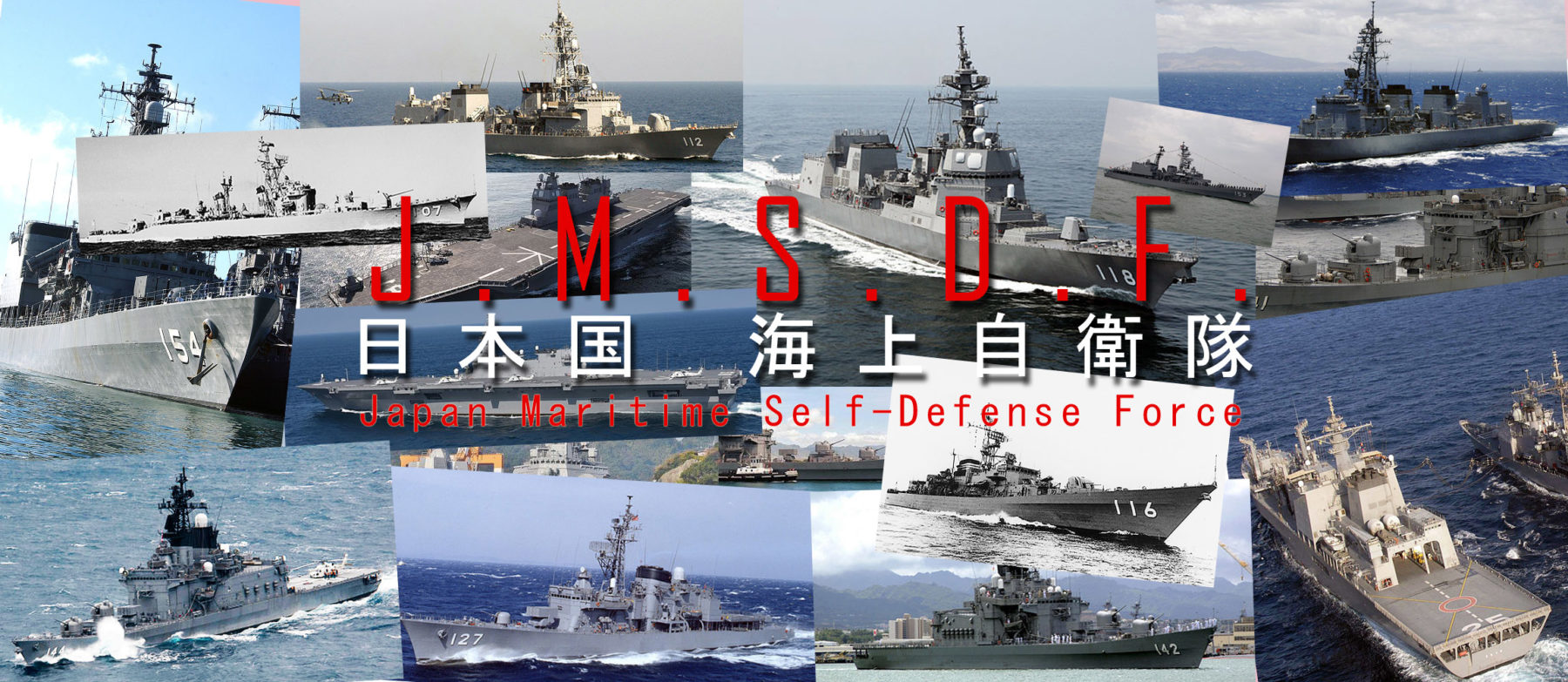
 Latest Facebook Entry -
Latest Facebook Entry -  X(Tweeter) Naval Encyclopedia's deck archive
X(Tweeter) Naval Encyclopedia's deck archive Instagram (@navalencyc)
Instagram (@navalencyc)





 Austrian Navy
Austrian Navy French Navy
French Navy Royal Navy
Royal Navy Armada Espanola
Armada Espanola K.u.K. Kriegsmarine
K.u.K. Kriegsmarine Dansk Marine
Dansk Marine Nautiko Hellenon
Nautiko Hellenon Koninklije Marine 1870
Koninklije Marine 1870 Marinha do Brasil
Marinha do Brasil Osmanlı Donanması
Osmanlı Donanması Marina Do Peru
Marina Do Peru Marinha do Portugal
Marinha do Portugal Regia Marina 1870
Regia Marina 1870 Nihhon Kaigun 1870
Nihhon Kaigun 1870 Preußische Marine 1870
Preußische Marine 1870 Russkiy Flot 1870
Russkiy Flot 1870 Svenska marinen
Svenska marinen Søværnet
Søværnet Union Navy
Union Navy Confederate Navy
Confederate Navy Armada de Argentina
Armada de Argentina Imperial Chinese Navy
Imperial Chinese Navy Marinha do Portugal
Marinha do Portugal Mexico
Mexico Kaiserliche Marine
Kaiserliche Marine 1898 US Navy
1898 US Navy Russkiy Flot
Russkiy Flot French Naval Aviation
French Naval Aviation Russian Naval Aviation
Russian Naval Aviation Sovietskiy Flot
Sovietskiy Flot Royal Canadian Navy
Royal Canadian Navy Royal Australian Navy
Royal Australian Navy RNZN Fleet
RNZN Fleet Chinese Navy 1937
Chinese Navy 1937 Kriegsmarine
Kriegsmarine Chilean Navy
Chilean Navy Danish Navy
Danish Navy Finnish Navy
Finnish Navy Hellenic Navy
Hellenic Navy Polish Navy
Polish Navy Romanian Navy
Romanian Navy Turkish Navy
Turkish Navy Royal Yugoslav Navy
Royal Yugoslav Navy Royal Thai Navy
Royal Thai Navy Minor Navies
Minor Navies Albania
Albania Austria
Austria Belgium
Belgium Columbia
Columbia Costa Rica
Costa Rica Cuba
Cuba Czechoslovakia
Czechoslovakia Dominican Republic
Dominican Republic Haiti
Haiti Hungary
Hungary Honduras
Honduras Estonia
Estonia Iceland
Iceland Eire
Eire Equador
Equador Iran
Iran Iraq
Iraq Latvia
Latvia Liberia
Liberia Lithuania
Lithuania Mandchukuo
Mandchukuo Morocco
Morocco Nicaragua
Nicaragua Persia
Persia San Salvador
San Salvador Sarawak
Sarawak Uruguay
Uruguay Venezuela
Venezuela Zanzibar
Zanzibar Warsaw Pact Navies
Warsaw Pact Navies Bulgaria
Bulgaria Hungary
Hungary

 Bundesmarine
Bundesmarine Dutch Navy
Dutch Navy Hellenic Navy
Hellenic Navy Marina Militare
Marina Militare Taiwanese Navy
Taiwanese Navy Chinese Navy
Chinese Navy Indian Navy
Indian Navy Indonesian Navy
Indonesian Navy JMSDF
JMSDF North Korean Navy
North Korean Navy Philippines Navy
Philippines Navy ROKN
ROKN IDF Navy
IDF Navy Royal New Zealand Navy
Royal New Zealand Navy Egyptian Navy
Egyptian Navy South African Navy
South African Navy

































 RN
RN
 Marine Nationale
Marine Nationale
 Soviet Navy
Soviet Navy
 dbodesign
dbodesign